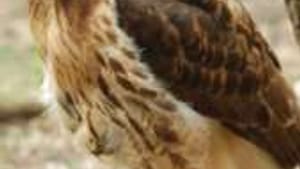Stay in the Loop
BSR publishes on a weekly schedule, with an email newsletter every Wednesday and Thursday morning. There’s no paywall, and subscribing is always free.
Mother Nature's wonderful world of killing (and one composer who's grateful for it)
The hawk, the hummingbird and the composer (Part I)

Careening diagonally across the top of my line of sight, a large bird swooped down and slammed into the holly branches not seven feet away from me, scattering sparrows and exploding their screeching imprecations all over what had been a peaceful early evening.
The time was last summer. The bird was a hawk, a red-tail, and young— these three facts were apparent in a split-second because a bird that size in this neighborhood is always a red-tail hawk, and the striated belly (noticeable even in the blur) is an adolescent's.
If the red-tail had targeted a particular bird for prey, it failed. But it stayed on its branch, first hopping, then shifting and twitching. Perhaps holly leaves were brushing against it, but it wasn't quitting the tree just yet. The sparrows warily sneaked to other, farther perches, their din of rage devolving into less frequent yells, then tut-tuts.
Strange sound
One sound, however, was different, and insistent. Only gradually did I notice it: a scree higher than the sparrows', raspy, buzzy like a cicada's but violent and quick.
I couldn't tell what it was, until I seemed to locate its source in mid-air, in what looked at first to be a large bug— a cicada? in mid-air?— or a junebug, or maybe a huge bee. No, bigger than…
Oh my, it's a hummingbird.
My wife and I were delighted when, a few years into living in Fox Chase, a hummingbird showed up. We've put up feeders and taken them down, in fits and starts, but coneflower and bee balm and butterfly bush we've grown all along. All those, and more, attract these hummers, as well as bees of different varieties, and monarchs, and black and yellow swallowtails. But the hummingbirds are still a surprise.
Predator or prey?
This one floated just a foot from the holly tree, near the telephone wire strung from the street to the house, screeling and then— look at that!— launching itself at the hawk. From one moment to the next, this contest went on: hover, launch, back, hover, launch.
Now I see that these attacks caused the hawk to twitch all this time. It very well may have run to the holly as a house of refuge— not to pounce on a bird, but to escape from one.
It was no use; the red-tail had offended, probably, by trespassing too close to a hummingbird nest, and the hummer would now exact its revenge. Again and again it launched, again and again the hawk twitched, sometimes feebly pecking the air.
Holmes and Moriarty
Tiring of the abuse, the young red-tail at last flew off. The hummingbird took off after it, and they torpedoed into the Norway spruce across the street, covered from view by drooping branches. They were gone only a few minutes, but it was long enough to make me think of Sherlock Holmes and Moriarty tumbling over the Reichenbach Falls.
But out they came, and straight for the holly, where the ballet of attacks resumed. This happened twice. The hawk could not shake its own hound of hell.
Then the red-tail had had enough and departed for good, leaving the holly behind, as well as the spruce, and fleeing over houses. The hummingbird followed but returned. It darted around the porch, hovered, and then rested on the telephone wire, swinging lazily in the air.
The orchestra calls
Earlier that day I'd received an e-mail message from Adam Lesnick, the executive director of Orchestra 2001, asking if I had a title for the short piece his orchestra and Piffaro had commissioned for their joint concerts in February 2013.
At that point I had a notion of what my piece would be, but not much more. At the time, the performance was a half-year away, with three deadlines still to meet before turning to this particular notion. But a title can be a good place to start, and it's certainly preferable to "New Work by." So as I walked onto the porch that peaceful early evening, to the corner of it next to the holly tree, I was searching for any inkling of a title.
And that's how Red-tail and Hummingbird got its name.
I make no claim to how others work, but my description of the composing of this work might demystify what is sometimes called the creative process, at least the shadows of it that I've been fortunate enough to inhabit. The creation of Red-tail and Hummingbird involves these two birds, as well as two tuning systems, Frank Zappa, Frank Lloyd Wright, Praetorius, undetermined instruments, a tango, luck, and a colossal mistake with an F-natural. But that will take another article.♦
To read responses, click here.
To read the next article in this series, click here.
The time was last summer. The bird was a hawk, a red-tail, and young— these three facts were apparent in a split-second because a bird that size in this neighborhood is always a red-tail hawk, and the striated belly (noticeable even in the blur) is an adolescent's.
If the red-tail had targeted a particular bird for prey, it failed. But it stayed on its branch, first hopping, then shifting and twitching. Perhaps holly leaves were brushing against it, but it wasn't quitting the tree just yet. The sparrows warily sneaked to other, farther perches, their din of rage devolving into less frequent yells, then tut-tuts.
Strange sound
One sound, however, was different, and insistent. Only gradually did I notice it: a scree higher than the sparrows', raspy, buzzy like a cicada's but violent and quick.
I couldn't tell what it was, until I seemed to locate its source in mid-air, in what looked at first to be a large bug— a cicada? in mid-air?— or a junebug, or maybe a huge bee. No, bigger than…
Oh my, it's a hummingbird.
My wife and I were delighted when, a few years into living in Fox Chase, a hummingbird showed up. We've put up feeders and taken them down, in fits and starts, but coneflower and bee balm and butterfly bush we've grown all along. All those, and more, attract these hummers, as well as bees of different varieties, and monarchs, and black and yellow swallowtails. But the hummingbirds are still a surprise.
Predator or prey?
This one floated just a foot from the holly tree, near the telephone wire strung from the street to the house, screeling and then— look at that!— launching itself at the hawk. From one moment to the next, this contest went on: hover, launch, back, hover, launch.
Now I see that these attacks caused the hawk to twitch all this time. It very well may have run to the holly as a house of refuge— not to pounce on a bird, but to escape from one.
It was no use; the red-tail had offended, probably, by trespassing too close to a hummingbird nest, and the hummer would now exact its revenge. Again and again it launched, again and again the hawk twitched, sometimes feebly pecking the air.
Holmes and Moriarty
Tiring of the abuse, the young red-tail at last flew off. The hummingbird took off after it, and they torpedoed into the Norway spruce across the street, covered from view by drooping branches. They were gone only a few minutes, but it was long enough to make me think of Sherlock Holmes and Moriarty tumbling over the Reichenbach Falls.
But out they came, and straight for the holly, where the ballet of attacks resumed. This happened twice. The hawk could not shake its own hound of hell.
Then the red-tail had had enough and departed for good, leaving the holly behind, as well as the spruce, and fleeing over houses. The hummingbird followed but returned. It darted around the porch, hovered, and then rested on the telephone wire, swinging lazily in the air.
The orchestra calls
Earlier that day I'd received an e-mail message from Adam Lesnick, the executive director of Orchestra 2001, asking if I had a title for the short piece his orchestra and Piffaro had commissioned for their joint concerts in February 2013.
At that point I had a notion of what my piece would be, but not much more. At the time, the performance was a half-year away, with three deadlines still to meet before turning to this particular notion. But a title can be a good place to start, and it's certainly preferable to "New Work by." So as I walked onto the porch that peaceful early evening, to the corner of it next to the holly tree, I was searching for any inkling of a title.
And that's how Red-tail and Hummingbird got its name.
I make no claim to how others work, but my description of the composing of this work might demystify what is sometimes called the creative process, at least the shadows of it that I've been fortunate enough to inhabit. The creation of Red-tail and Hummingbird involves these two birds, as well as two tuning systems, Frank Zappa, Frank Lloyd Wright, Praetorius, undetermined instruments, a tango, luck, and a colossal mistake with an F-natural. But that will take another article.♦
To read responses, click here.
To read the next article in this series, click here.
What, When, Where
Orchestra 2001: Joint concerts with Piffaro, the Renaissance Wind Band, and soprano Julianne Baird. February 22, 2013 at Trinity Center, 2212 Spruce St.; Feb. 23 at Presbyterian Church of Chestnut Hill, 8855 Germantown Ave.; Feb. 24 at Lang Concert Hall, Swarthmore College, Swarthmore, Pa. (215) 893-1999 or www.orchestra2001.org.
Sign up for our newsletter
All of the week's new articles, all in one place. Sign up for the free weekly BSR newsletters, and don't miss a conversation.

 Kile Smith
Kile Smith